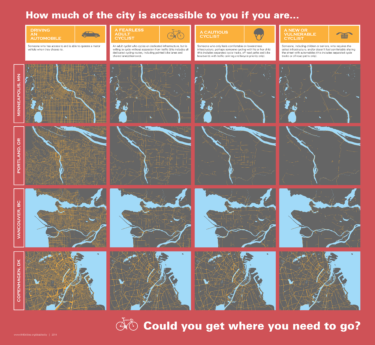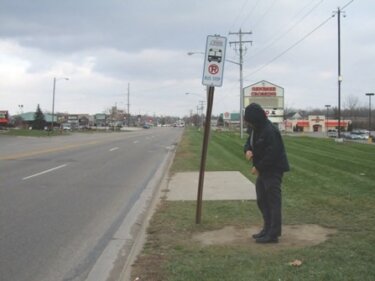"It helps to compare cities and their transportation systems to forests. Rich, diverse ecosystems are always healthier and more resilient than monocultures. Just as a mixed forest can better survive a beetle infestation than a tree farm consisting of one variety of pine, a city that enables endless combinations of mobility will be much more resilient than a city that organizes itself around just one way of moving."
The Doable City Reader
There is so much that can be done to make our cities happier, healthier and more prosperous places. Every day in cities around the world, citizens and city planners alike are showing us how small actions can scale up to have massive impact. And they can in your city too.
That’s what the Doable City Reader is about. In June 2014, 8 80 Cities, in collaboration with the Knight Foundation, brought 200 civic innovators from around North America together in Chicago at the Doable City Forum to share and discover methods for rapid change-making. The Doable City Reader is inspired by the rich conversations amongst presenters and participants at that forum. It is a resource for any and all people who want to make change in their cities and is meant to educate, inspire and empower anyone to do so.
Imagine this: you’re driving on a highway when you encounter large signs directing you to stop, get out of your car and push it for 50 metres before proceeding. This is the absurd scenario Andreas Rohl, Copenhagen’s bicycle program manager, asks audiences to entertain when giving talks around the world about how to create world-class bicycle infrastructure.
His conceit is often met with chuckles. But his point is salient: “You would never accept that,” he explains. So why would you ask this of cyclists in order for them to get safely from one bike lane to another on their way from A to B?
Far too often, pieces of city infrastructure — whether bike lanes, parks or transit lines — are conceived of and built piece by piece. But just like how the roads in a city are only useful because they’re all connected to one another (as well as to highways, parking lots and gas stations), it is critical that other systems be designed in the same way: as rich networks interwoven in a symbiotic relationship with other networks. The more we do that, the more useful every individual piece becomes.
Getting from A to B (and all points between)

A lack of network thinking is often most glaring when it comes to cycling infrastructure. For instance, take these maps to the left of bicycle facilities in Portland, a city famous for its cycling culture. Although the entire cycling network, deemed the “fearless adult cyclist” map in this graphic, may appear complete at first glance, numerous studies have shown that the vast majority of people do not feel comfortable cycling mixed in with traffic without separated bike lanes and will only get on their bikes regularly if they can ride separated from traffic. Even the kamikaze cyclists that will ride in any environment strongly prefer this type of infrastructure and will go out of their way to use it. So for the majority of the population, only the routes on the last map, deemed “new or vulnerable cyclist” in the graphic below, are actually usable. For such a person, there is no possible route from one part of the city to another. Only a few blocks here and there are available to them, along with the occasional recreational trail, so, more often than not, there’s no way for them to get where they’re going. (Also see similar map graphics of Minneapolis, Minn. and Vancouver, B.C.).

This is the case in most cities throughout North America, which helps explain why even the continent’s most lauded cycling cities still don’t see more than about 5 per cent of their population regularly commuting by bike. On the other hand, similar maps of Copenhagen show a different story: they barely change at all. A rich and highly connected network of bike lanes appropriate for all ages and abilities to get anywhere they need to go exists throughout the city — one of the main reasons that 40 and 55 per cent of Copenhageners commute daily by bike in the region and city centre, respectively. Studies show that people are only willing to go so far out of their way to find dedicated cycling infrastructure. In Copenhagen, they don’t have to.
The same concept applies to public transportation. Many cities spend billions of dollars arguing for and building subways or other major rapid transit lines, but then fail to develop strong connections to fill the space between them. It’s great if someone is able to take the subway very quickly to a stop near to their neighbourhood, but if they are stuck waiting for a long period of time for a slow and lumbering bus to carry them the last leg of her journey home, that rapid transit line is considerably less convenient.
The places we go
Even public spaces can be thought of as part of a network. As Jeff Risom of Gehl Architects pointed out at the Doable City Forum, this is not necessarily because a person moves from one space to another all in the same day, but rather because different parks and public spaces serve different purposes throughout the week, month or year — from the small neighbourhood parks where dogs are walked daily, to the megaparks that draw people occasionally for major concerts and city events.
On top of that, citizens only benefit from parks and public spaces if they actually use them, which means that having many scattered throughout the city is critical for them to best serve their purpose. For example, one study in Los Angeles showed a significant correlation between residents’ proximity to a park from their home and their mental health. After controlling for other variables, the study found that the farther away from a park residents lived (which correlated with fewer visits to the park), the less likely they were to get the recommended daily dose of physical activity and the more likely they were to experience psychological distress.
This is one of the reasons why former New York City mayor Michael Bloomberg insisted in his sustainability and resiliency plan (PlaNYC) that every New Yorker live within a five- to 10-minute walk from a park at most. Central Park is a standout feature of New York City thanks to its size and stature, but if it were the city’s only park, it would contribute very little to overall quality of life for most New Yorkers.
Integration is key
In the same way that one bike lane or transit line or park is exponentially more useful and efficient when connected to many others, networks of public spaces and pedestrian, cycling and transit infrastructure must work together in order to function at their potential.
Everyone who takes public transit, or drives, for that matter, is also pedestrian or a cyclist on either end of his trip. Ensuring that people can get to and from the station comfortably and quickly is one of the major factors that will determine whether or not they will take transit. This goes beyond just making sure that routes close to transit stations have sidewalks, for instance, though that’s an important start. It also means integrating bike share systems with transit systems, having secure bike storage facilities at transit stations, enabling people to take their bicycles on transit with them, and having short, direct walking routes to transit which ideally also offer amenities along the way.

Inadequate connections between networks can produce enormous barriers. For example, a study in Houston found that three out of five disabled and elderly citizens do not have sidewalks between their home and the nearest bus stop. As a result, fewer than 10 per cent of them use public transit, despite the fact that 50 per cent live within two blocks of a bus stop.
On the flip side, however, the benefits of well-integrated networks done right can also be enormous. For example, the Portland Bureau of Transportation’s bicycle program estimated that making public transit more friendly and accessible for cyclists made the capture area of transit investments 12 times greater, because cycling extends the potential reach of the transit network so greatly.
Similarly, Chicago Parks District chief of staff Gia Biagi views good pedestrian, cycling and transit connections as essential to the success of the city’s park system as they make more types of parks more accessible to more people.
Cities, like many things, are so much greater than the sum of their parts — when and because those parts work together to build the whole.
This chapter is available as a PDF: download a copy.

